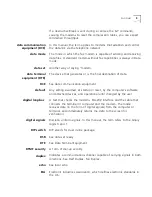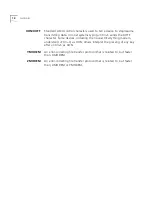
G
LOSSARY
7
handshaking
A sequence that two modems undertake while connecting to agree o
the parameters of the conversation that will ensue. During
handshaking, the modems negotiate the speed of the connection,
whether error control and data compression will be used and in what
form, and so forth.
hardware flow
control
A form of flow control that uses electronic signals to start and stop the
flow of data.
HDLC
See High Level Data Link Control.
High Level Data Link
Control (HDLC)
A standard protocol developed by the International Standards
Organisation for software applications and communicating devices
operating in synchronous environments. The protocol defines
operations at the link level of communications, for example, the format
of data frames exchanged between modems over a phone line. See
Bisync, Protocol, SDLC.
High Speed
Technology (HST)
3Com' proprietary signaling scheme, design and error control protocol
for high-speed modems. HST incorporates trellis-coded modulation, for
greater immunity from variable phone line conditions, and asymmetrical
modulation for more efficient use of the phone channel at speeds of
4800 bps and above. HST also incorporates MNP-compatible error
control procedures adapted to asymmetrical modulation.
Hz (Hertz)
A frequency measurement unit used internationally to indicate one
cycle per second.
Industry Standard
Architecture (ISA)
The most common type of computer expansion bus. Other types
include Extended Industry Standard Architecture (EISA) and
Microchannel Architecture (MCA).
interrupt request
(IRQ)
A number that must be assigned to devices that plug in to your
computer's expansion bus.
IP
Internet Protocol.
IPX
Novell's Internet Packet Exchange protocol.
IRQ
See interrupt request.
ISA
See Industry Standard Architecture.
ITU-T
International Telecommunication Union-Telecommunication sector.
Formerly referred to as CCITT. An international organisation that defines
Summary of Contents for Courier
Page 12: ......
Page 28: ...1 14 CHAPTER 1 CONNECTING TO YOUR ISP ...
Page 36: ...3 4 CHAPTER 3 UPGRADING YOUR MODEM ...
Page 58: ...6 6 CHAPTER 6 WORKING WITH MEMORY ...
Page 64: ...8 4 CHAPTER 8 CONTROLLING EIA 232 SIGNALING ...
Page 72: ...9 8 CHAPTER 9 ACCESSING AND CONFIGURING THE COURIER V EVERYTHING MODEM REMOTELY ...
Page 80: ...10 8 CHAPTER 10 CONTROLLING DATA RATES ...
Page 96: ...12 6 CHAPTER 12 FLOW CONTROL ...
Page 108: ...13 12 CHAPTER 13 HANDSHAKING ERROR CONTROL DATA COMPRESSION AND THROUGHPUT ...
Page 112: ...14 4 CHAPTER 14 DISPLAYING QUERYING AND HELP SCREENS ...
Page 122: ...15 10 CHAPTER 15 TESTING THE CONNECTION ...
Page 142: ...17 8 CHAPTER 17 TROUBLESHOOTING ...
Page 156: ...A 14 APPENDIX A S REGISTERS ...
Page 172: ...B 16 APPENDIX B ALPHABETIC COMMAND SUMMARY ...
Page 178: ...C 6 APPENDIX C FLOW CONTROL TEMPLATE ...
Page 186: ...E 4 APPENDIX E V 25 BIS REFERENCE ...








































